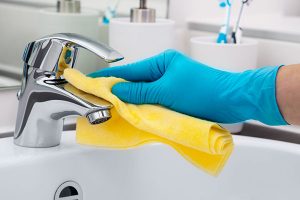Are you ready for Spring Cleaning? – Bathroom Cleaning 101: What You Need to Know
 Spring cleaning isn’t always fun, but it is necessary. Thorough cleaning of your bathroom this time of year will help it stay cleaner month to month and keep this routine household chore from turning into a project you dread. Here are some answers to a few common questions about cleaning bathrooms to help you get started.
Spring cleaning isn’t always fun, but it is necessary. Thorough cleaning of your bathroom this time of year will help it stay cleaner month to month and keep this routine household chore from turning into a project you dread. Here are some answers to a few common questions about cleaning bathrooms to help you get started.
What is The Dirtiest Place in the Bathroom?
The toilet, tub and sink are obvious choices and are essential places to clean. But the dirtiest place in the bathroom may be the floor. Right after a good cleaning of the toilet, tub or sink, the bathroom floor might have a thousand bacteria per square centimeter. Just an hour later, that number can go up to a million, especially if the toilet has been flushed with the lid open. Don’t forget about your disposable toothbrush holder either. According to the National Sanitation Foundation, toothbrush holders should be cleaned at least once a week to kill germs — throwing them in the dishwasher is an easy option. If you use a loofah sponge, you might also be surprised to learn that experts recommend replacing it with a new one every couple of weeks.
How Harmful is Bacteria in Bathrooms?
Many types of bad bacteria can be found in this intimate space. E-coli, streptococcus, paratuberculosis and salmonella are just a few of the bacteria that may be present, and each can cause illness. Make sure everyone washes his or her hands after using the toilet, and clean bathrooms on a regular schedule to keep bacteria from hanging around.
How To Clean A Bathroom?
The best practice is to set a scheduled day and time to clean your bathroom and stick to it. Plan to store toiletries away from any cleaners and chemicals. Merry Maids has some handy tips for the most important places to clean in your bathroom and how to do so with ease.
Wipe Down Everything. Disinfectant sprays or wipes kill germs on contact, so use them on faucets, toilet handles, cupboard handles, doorknobs, shower door handles and anywhere else you touch with your hands. This includes the toilet brush handle and plunger handle, which are often overlooked.
The Shower. For a scum-removing solution, mix one-quarter cup of vinegar and three-quarters cup of water in a microwave-safe bowl and heat before loading the solution into a spray bottle. Spray surfaces (but not stone floors) with the mixture and let that sit for about three minutes. Then, wipe down all surfaces. Take out the bathtub stopper and hair catcher and get rid of any gunk. It’s not the most pleasant task, but it will help keep your drain clog-free.
The Tub. Before you start scrubbing the tub, note whether it’s porcelain, enamel, acrylic or plastic. Porcelain tubs are pretty tough, but enamel, acrylic and plastic tubs can fade or get scratched by harsh chemicals. Avoid bleach or vinegar when cleaning enamel and acrylic tubs. It’s smart to test a spot first to rule out potential stains or damage.
The Sink. The sink is a miniature version of the tub, so treat it with the same care. Follow the same directions and take precautions to make sure the cleaners you’re using are safe for that surface.
The Toilet. Scrub the inside of the toilet bowl at least a couple times a week with products that contain bleach. Wear gloves to protect your hands and use a toilet brush to get under the rim. Thoroughly clean every part of the toilet seat and wipe down the toilet tank, lid and side as well.
The Little Things. Polish a toothpaste-stained mirror with glass cleaner and a soft microfiber cloth or paper towel. Sweep and mop the floor and scrub the grout with a grout cleaner and a brush. Don’t forget to check all your products, from grout cleaner to mildew remover, to make sure they’re safe for the surfaces you’re working on. Happy scrubbing!
